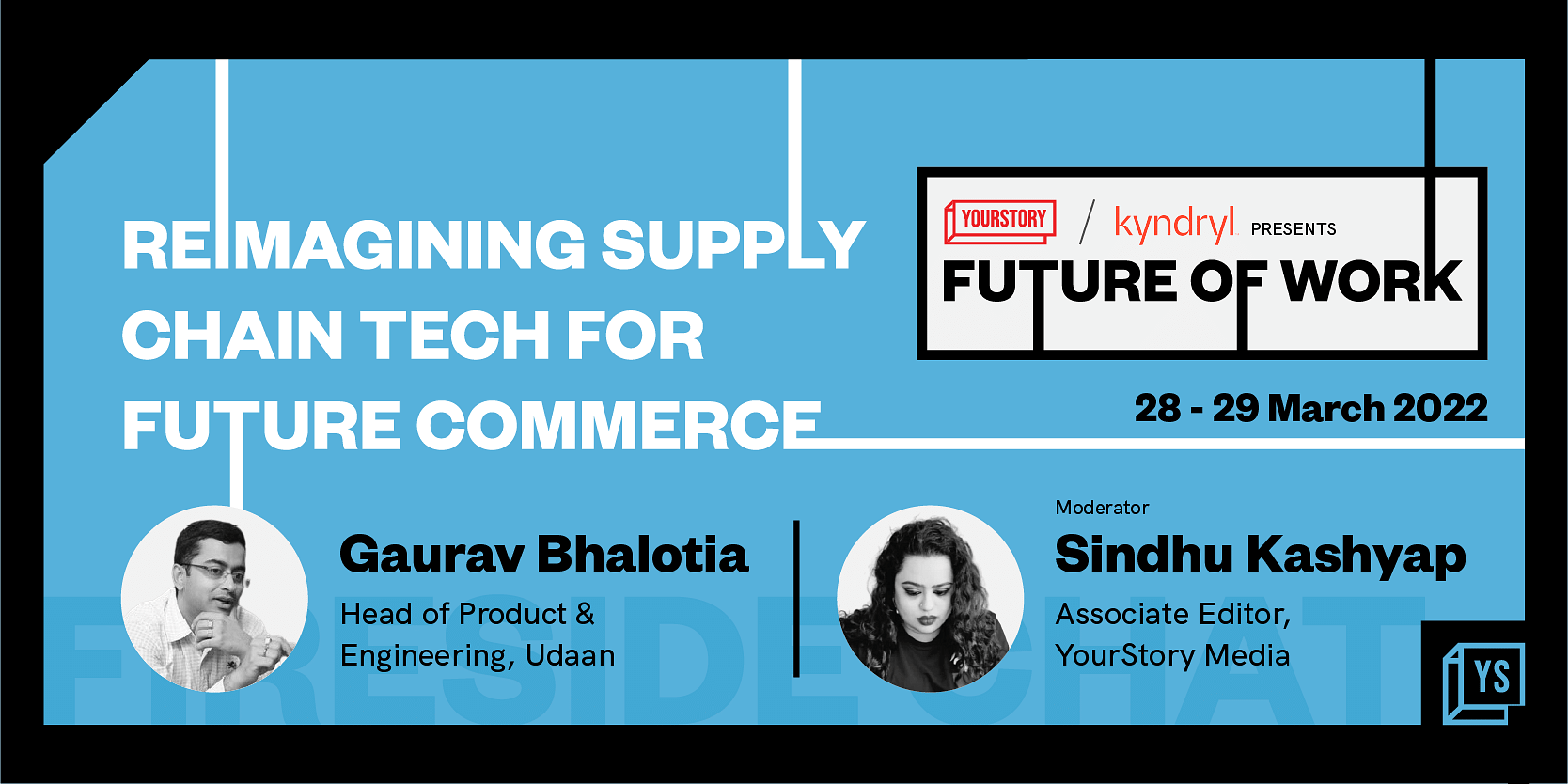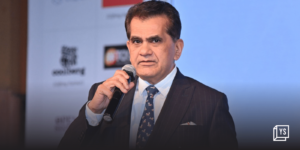“Your customer is the ultimate judge of what you have built. Is the customer ready to use what you are building? Are they ready to repeat? If you withdraw that product, will they feel a void? Will they come back to you and say ‘No, I want that product’. Finally, are they willing to pay? Are they willing to pay for what you have done?” asked Gaurav Bhalotia, Head of Technology, Udaan, the B2B (business-to-business) ecommerce unicorn, talking about some of his learnings as a technology leader.
Gaurav was speaking with YourStory’s Associate Editor, Sindhu Kashyap at YourStory’s Future of Work conference 2022, when Sindhu highlighted how Udaan has been “making” life easier for retailers across the country. While India’s vast network of kirana stores have been delivering groceries and daily essentials since what now seems like time immemorial, the hustle and bustle and the chaotic energy of service providers working tirelessly to ensure the timely delivery of products at the doors of retailers is real. And that’s exactly where a platform like Udaan comes into the picture. Incorporated in June 2016 and launched a year later, Udaan created waves in the startup world by achieving a unicorn status in September 2018.
It has been an “interesting ride” for the technology trailblazer, whether as an angel investor, mentor, entrepreneur, or now in his current role at Udaan. The former Vice-President of Engineering at Flipkart, Gaurav managed and bootstrapped multiple platforms and contributed to building a strong ‘technology ORG’ from India. Gaurav joined the Udaan family in September 2021, to translate the platform’s vision of being a game-changer in the Indian retail industry by leveraging technology.
Creating technology with clarity, motivating the team for building with the end goal in mind, thinking about scale, solving the right problems, not just the problem in hand but thinking of what else can be possible, as eventually, that’s what actually defines whether you are working at a startup or in a big company, are some of the other key learnings that Gaurav shared at the conference.
“We have an amazing leadership team. It requires the right team to solve the problem,” shared Gaurav, adding how the journey began with the outlook to contribute towards India, to make it happen for all stakeholders. The journey was aimed at the goal of redefining how Indian shops find products, both essential and non essential. Gaurav also highlighted how Udaan takes pride in its vibrant technology culture.
Udaan, connecting miles across India
The retail industry is over $1 trillion, and the B2B ecommerce space offers close to $60-billion revenue opportunities. The key conversations in the sector are around revamping and adapting to newer consumer preferences, especially as it is critical now for businesses to go digital.
“Customer expectations are changing. And I think a lot of it is influenced by the experiences they have right on the B2C (business-to-consumer) side. Our buyers are big consumers of the B2C apps. So, I think the baseline is shifting,” shared Gaurav.
Customers today have all-time high expectations. Gaurav added how customers today demand accuracy, leading to the need for faster and more reliable deliveries, which, in turn, demands aggressive service levels.
Companies have tried to crack the code by employing various new-age technological trends, such as AI (artificial intelligence), robotics, and self-driving vehicles. With growing consumer expectations, the term ‘omnichannel’ has also gained much currency, Gaurav pointed out.
“But I think it is important to get your products to the customer where they are; it’s important to reach where they are,” said Gaurav. He explained how one of Udaan’s top priorities is to reach customers where they are, spread across the entire length and breadth of the country; to reach 14 million or so retailers across the spread of the country. Bridging divides, and connecting miles across India, captures the essence of Udaan’s big retail flight.
The goal is to use a combination of apps and other channels like WhatsApp, to tap various touchpoints in customers’ journey. Gaurav shared that he believes technology has to cope in order to build that unified layer. “You need to own a customer’s journey; know where they are, irrespective of where they are coming from. If they come on the app, you would, of course, want to show them the current context of where their order is, or any other touchpoints as that would be an expectation. I think a lot of companies are building that backbone. And these are things which form part of the cloud infrastructure,” he explained.
Reimagining the supply chain by integrating technology
Gaurav spoke about the key cost centres of integrating tech to reimagine the supply chain. “They start with all the physical facilities including the warehouses, and then go on to some of the specialised talent and skill sets you bring around design. So, there is facility design and there is network design. There has to be a technology team building the right platform, starting from the promises you make to managing the material movements. Managing the inbound-outbound processes is important. And, finally, running the operations is also critical,” he shared.
Balance is the operative word when it comes to elevating the supply chain to plug in evolving needs. “Balancing the reach in the supply chain is important. How many cities? How many PIN codes can you deliver to?,” Gaurav asked. The other imperative is cost. “Can you do this at the right cost, which works for your business?,” he added, explaining why balancing the service levels with the promises made and rising customer expectations should be part of the approach.
“At Udaan, we want to execute the ‘next-day delivery’ model for 5,000 plus cities. What technology can do is get everything systematised, all of these process workflows are mapped to systems. So, it starts with visibility on what is happening. Then comes the interventions to address gaps, and making them more efficient. The third factor is automation — from ML to robotics. “I don’t think you can afford not to have them. They’re becoming table stakes. So, we invest in a lot of those. How do you actually profile products? How do you actually start the grid? How to keep vegetables fresh as they come in? So, you have to have robots start doing a lot of it,” shared Gaurav.
Working on what truly matters
One of the problems which technology teams face day in and day out is they have much to do. Prioritisation is the key here. Figuring out what is more important is important to solve the problem of many.
From building the right features, to building for scale and the right reach, the technology being built should be able to tick the right boxes. The other thing is once built and if successful, you would actually want to immediately add new things, Gaurav pointed out. So, the right way to do that is to always have iterative tech creation. “So, we have to very judiciously find what is the minimal viable product? [Products] Which will get things done. Some of the things like scalability have become table stakes. The mantra should be: do I have an ability to use an external solution to do what I want? Cloud is an example, which allows you to build something with the scale, reliability, and focus on what is important for you.,” shared Gaurav.
Ask yourself: will it contribute value to the business? “As a startup, if something is doable with spreadsheets, don’t try to build fancy software for it,” he surmised.
Hiring techies and building a great tech culture
To build the right technology, it is important that you actually solve the problem. Did you solve the problem of the user of the business? “One of the things we look at in our engineers, product engineers and even software engineers, is that while our engineers need to have their technical chops from coding to design, architecture, and understanding problem solving, they also need to have a very good product orientation. Are you able to understand the problem, do you have a larger understanding of the space? How is your product going to fit in that ecosystem? What will define success?,” he shared.
Garuav highlighted how their past work is a good indicator. “The key questions to ask: What kind of outcomes have been created? What has this individual championed? And how has the individual learned from their past failures since no product is perfect at the first outing? What have they taken away?,” he added.
What is the biggest priority for Udaan? “Immediate unlocking versus building for the future, where we can really reduce barriers to entry and, finally, building an integrated journey for the user,” signed off Gaurav.




![Read more about the article [Funding alert] The Whole Truth raises $6M Series A round led by Sequoia Capital](https://blog.digitalsevaa.com/wp-content/uploads/2021/07/Imageaipg-1627389759783-300x150.jpg)





